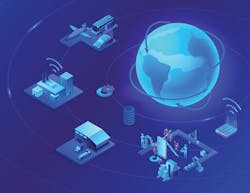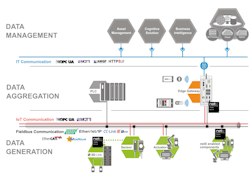Networks Take Center Stage
As industry undergoes its digital transformation, networks often seem to be taking the spotlight away from controllers in many automated processes. Sure, controllers still play a crucial role, but not as squarely positioned center stage as they once were.
The reason is the growing popularity of the distributed control premise promoted by Internet of Things (IIoT) and Industry 4.0 initiatives. More and more devices now have programmable microcontrollers built into them, and conventional controllers are increasingly being placed closer to the devices rather than in centralized cabinets. Like other devices on the network, these distributed controllers are reporting data over the network for aggregation, visualization, and analysis elsewhere.
The result is a new architecture, one that flattens the classic Purdue model that segregated operations technology (OT) from information technology (IT) and strictly controlled the flow of data between them. “Instead of moving data in only one direction—from the plant floor, through middleware, and into back-office systems—the new model seeks to move data back-and-forth between all systems,” explains Josh Eastburn, director of technical marketing at Opto 22. The network is at the center of this information flow.
When this trend toward a new center reaches maturity, the affected automation systems will be decentralized, but interconnected via the network. “Every device will be able to see its neighbors and the cloud,” predicts Yuri Chamarelli, lead product marketing specialist of control systems at Phoenix Contact. “Every byte of data being generated in the field will have a digital twin.”
This shift toward network centricity is being driven by a number of technical developments in the industrial networking space. Among them are the adoption of industrial real-time Ethernet (RTE) down to the sensor level. “With RTE down to the device level, you can now service multiple data consumers beyond the controller,” explains Jamie Gallant, embedded solutions manager at Hilscher North America. RTE is increasingly being made possible by application-specific integrated circuits (ASICs) in communication chips like Hilscher’s netX 90.
Industrial network communication organizations—such as ODVA, Profibus/Profinet International, FieldComm Group, FDT Group, IO-Link, and the OPC Foundation—have also helped to streamline data consumption by developing device profile extensions that provide a common way to access information, regardless of vendor and network protocol. “Making the device status and diagnostic information generic means that it can be easily accessed to analyze the performance of the device and, therefore, the efficacy and reliability of the equipment,” says Gallant.
Besides these new standards for data types, another technical development supporting the shift in center has been innovation in microprocessor technology. “With hardware that has 10 times the horsepower of systems of 15 years ago, but costs a fraction of traditional systems, the decentralized topology becomes more attractive,” notes Chamarelli.
“With more horsepower, you can support data consumers with extended data types,” adds Gallant. Support can also come from other tehcnologies, such as edge devices that can send data to higher-level systems or cloud-based applications without the need for reprogramming controllers.
The disputed center
Despite these developments, not everyone agrees that it’s accurate to say the network is becoming the center of automation. Some, for example, argue that it is more accurate to say that the new center is really the new generation of analytics fostered by IIoT and cloud services.
“The network doesn’t actually do anything apart from moving information from producers of information to consumers of it,” notes Paul Brooks, manager of technology business development at Rockwell Automation.
He adds that automation and control technologies have evolved to promote distributed control and data reporting over networks. “While the ability to control processes must remain the number one priority, the ability to deliver large amounts of secondary information about those processes will come a close second, overtaking things like ease of replacement and price,” says Brooks. “A servo drive may have 150 parameters that are used to directly control the motor, but it has 4,000 internal parameters that can be used for long-term monitoring and process optimization.”
Not only can users now see information that they couldn’t before, they can also benefit from new capabilities, such as cloud-based analytics and fleet management of machinery. “The real significance is changing business models and the ability for entities throughout the value chain to offer more and more capabilities as a service,” says Brooks. In this sense, the analytics and other services made available through the network becomes a new center for automation.
Whether the shift is toward analytics or the network itself, Brooks stresses that controllers will continue to play a crucial role in automated processes. One reason being that the movement of information from its producers to its consumers can happen smoothly only, “if controllers continue to do everything that they do today—and do it better,” says Brooks.
Another reason is that the need for the automation and control functions has really not changed.
Rick Peters, chief information security officer for operational technology at Fortinet, agrees. “The discrete functions are still being performed,” says Peters. “The intelligence is being reported and analyzed over the network to ensure clear situational awareness across the OT network.” He sees the proliferation of IIoT devices as a way to promote the convergence of the OT and IT infrastructures to improve efficiency.
Because controllers are still performing their traditional tasks and are often doing more, Peters and others don’t see controllers being displaced as the center of many automated facilities. “The network is a critical enabler in connecting the different automation components together, but it is not displacing the controller element,” argues Sean Sims, vice president of DeltaV platform marketing at Emerson. “Controllers are still central to automation architectures today and will be in the future.”
Dealing with complexity
Part of Sims’ reasoning is that control in the field requires dealing with complexity. “Most control strategies involve multiple process inputs and outputs, and sometimes hundreds of controllers, and a significant amount of contextual information regarding the current state of the process,” he explains. “Consolidated controllers remain the most efficient and structured manner to host these critical process and contextual functions. Security, redundancy, component lifecycle management, and integrated configuration change management are critical and more easily implemented within the consolidated controller environment.”
Sims also thinks that, in most cases, logical control boundaries and process design—not technology—will govern most implementations of centralized and distributed control architectures. For him, chasing the latest technology, rather than focusing on safety, reliability, and quality, is the main pitfall in specifying process automation. “The right technology should keep the important characteristics of control systems, such as superior control algorithms, ease of use, reliability, redundancy,” says Sims. “It should then build on that by adding better data management, handling, and visualization.”
Another factor influencing views on controller-centric versus network-centric is the industry that you happen to work in. “The discrete-manufacturing industries are probably seeing more of a distributed, network-centric control strategy because it increases the flexibility of machinery,” observes Bernd Raithel, the director of marketing at Siemens Factory Automation. “Smaller controllers have become much more powerful and capable over the last 15 years or so.” This, in turn, has made it more cost-effective to design and build machines that have smart modules that can be programmed to handle a variety of jobs.
Raithel expects this trend to extend beyond the machine level to include the larger manufacturing process. Here, the modular approach will translate into more production cells and islands of automation that are connected by the network and tended by automated guided vehicles and robots. “All the logic will be more flexible, so you don’t have to change over a line just to move from processing one part to another,” says Raithel.
For today and tomorrow
To excel in such distributed, network-centric environments, controllers should have some particular capabilities that give them flexibility. Because the movement toward these kinds of distributed networks will likely take place slowly over time, Chamarelli recommends technology that will support both the old and the new. “It’s easier to make a decision when you know that your current team can do things the way it did before but have the additional functionalities for taking your systems into the future,” he says.
For this reason, Chamarelli recommends controllers capable of running Linux because it is an open operating system that can help accommodate innovation. “The future of industrial automation will come from the big tech network systems, and those are Linux-based,” he says.
Another way to prepare for increasingly distributed environments in the future is to specify modular controllers. “Not everyone is going to be putting AI (artificial intelligence), for example, in the factory in the next year,” says Raithel. “So, you need a system that satisfies today’s needs for robustness and reliability but gives you flexibility to add capabilities later.” For this reason, he urges engineers to consider controllers that allow adding options, such as AI, as modules.
Raithel also advises engineers to prepare for an increasingly network-centric environment by specifying edge-enabled controllers. “This means that the device can run conventional controller code and IT code like C or Python,” he says. It combines the functionality of today’s robust controllers with that of an edge device of the future.
In an environment where the network is the core of operations, connectivity options are also a key concern for specifying a future-proof controller. “For the IIoT, next generation automation systems need to be both future-proof and backwards compatible,” notes Michael Britt, OEM solutions manager at Hilscher. “Because current industrial networking protocols will not disappear, all existing standards and current practices must still be supported and coexist in this new ecosystem.”
“Users need the ability to integrate into a variety of network schema, so multiple communication interfaces and support for a variety of OT and IT protocols are a must,” adds Eastburn. “Ideally, this support should extend beyond communication to include device configuration and management.” It might even include protocols like DNS and DHCP that are common in consumer and enterprise IT devices, but rare in industrial devices.
Eastburn also points out that, in a network-oriented architecture, a controller’s value increases with the number of layers that it can cut across. “So, users should look for things like embedded OPC, MQTT, VPN, and REST support that let them move data directly to databases and applications,” he says. Another useful tool for controllers and devices like edge I/O and gateways is Node-RED, a language designed for extracting, transforming, and moving data among various networked devices.


